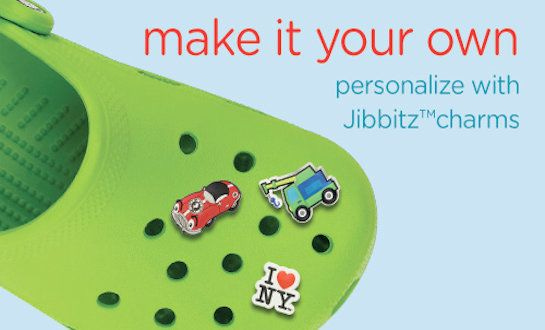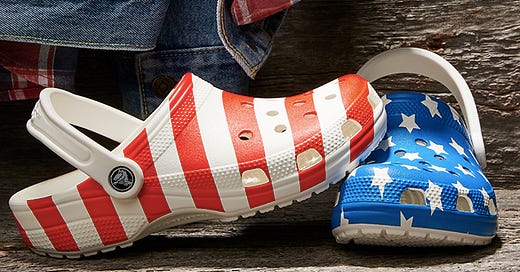The Times Worst Invention of Human History to a Billion-Dollar Phenomenon - The Rise of Crocs
Just ugly or strategically bad?
The story of crocs has been one of ups and downs, from having revenue of more than $108 million in 2005 to going nearly bankrupt in 2008. Then came the unlikely return of the aesthetically unappealing one, as crocs sold over 700 million pairs of footwear over the next decade.

The Crocs clog is perhaps the most divisive shoe on the market. The difference in opinion between the lovers and the haters is so extreme that the debate often feels more appropriate for politics, not fashion. A Facebook page called "I don't care how comfortable Crocs are, you look like a dumbass," for example, has more than 1.2 million followers.
This story is a masterclass in exploiting the sentiments and tension revolving around the brand.
These wild, wacky and wonderful clogs were born in 2002 by three innovators: Scott Seamans, Lyndon Hanson, and George Boedbecker Jr. On a particular fishing trip, Seamens was wearing a pair of slip clogs which the other two found ugly but were sold on their functionality. The first model produced by Crocs, the Beach, was unveiled in 2002 at the Fort Lauderdale Boat Show in Florida and sold out the 200 pairs produced at that time. The company showed insane levels of growth in the period 2002-2005, with revenues skyrocketing to over $108 million. The company raised over $200 million in its 2006 IPO, the greatest by a footwear company. This was also the time when they acquired Jibbitz, an accessory company meant to personalize your simple crocs. 2007 was the single most profitable year for the company till that point with net income breaking the $150 million barriers. People loved that they were comfortable, and were quickly becoming the hot thing.

Then came 2008, the stock price pummelled from $68 to just over $1. This is where the first problem came up, crocs had expanded majorly in 2007, trying to meet its demands to keep investors happy, with multiple products and showrooms, when the crisis hit in 2008, the company had huge amounts of unsold inventory. The company had grown fast, but that growth was not sustainable. It fell to commit a common mistake for young companies, it tried to provide everything to everyone, it had moved into over 90 countries and had 2 years of excess inventory to move.

In 2014, Andrew Rees joined crocs, with the company still struggling to find its standing in the market again, the growth from here on made them the social statement that they are today. Under him, the company closed underperforming stores, cleaned up its distribution channel, and reduced its product offerings by over 80%. They went back to basics, what they were good at, a comfortable clog. This comeback was helped by its timing in the fashion world and several brilliant marketing strategies and executive decisions.

UGLY, NOT SO UGLY ANYMORE
One of the factors that helped crocs was the emergence of a fashion movement that favoured comfort over fashion. Crocs found a new stylish audience to target, within the rise of 'I-don't-care' fashion. The mentality of this trend could be defined as the more questionable or conventionally 'ugly', the better. CEO Andrew Rees says. "Our goal is not to make the haters love the brand. It's to exploit that extrinsic tension because it creates opportunity, it creates PR, it creates media, it creates interest. It creates a whole lot that would cost you a fortune to buy in other ways." Crocs have wonderfully used the tension between the lovers and haters to create an air of marvel around itself, allowing it to never leave the eyes of a consumer. The 2006 acquisition allows people to personalize their otherwise simple crocs, making them not JUST footwear but a statement of personality, something that has found great resonance with its target customers, teenagers and millennials.

HIGH-END COLLABORATIONS
High-end collaborations have helped the company get visibility and reignite consumer interest time and time again. The sheer breadth of the collaborations, from KFC to Balenciagas and from Post Malone to designers like Christopher Kane, crocs have proved that they can appeal to a wide range of consumers. With high fashion, streetwear, and hip-hop catered to, Crocs is now in the bizarre position of being the coolest uncool thing out there. Before he collaborated with Crocs, Post Malone tweeted, "U can tell a lot about a man by the Jibbitz in his Crocs."

Even in times of pandemic crocs have continued to rise, the march 2020 sales were 14% higher than the same period last year. What's more, Google searches for Crocs touched a 15-year high in April and the shoes are on Amazon's bestseller lists. From just under $11 the stock is over $35 today. Again crocs used the love-hate relationship it has among the masses to their advantage. They were the perfect shoes to wear for comfort when no one can see, the stock price for the company rose through the pandemic.
Crocs have proven to be a great learning experience for companies in different stages of growth, they committed mistakes through their comparatively small 18-year history but have learnt from them and are today one of the most favoured brands for teens and millennials in the world, they have relished healthy controversy, worked towards a sustainable model and above all, stuck to their core principle.


